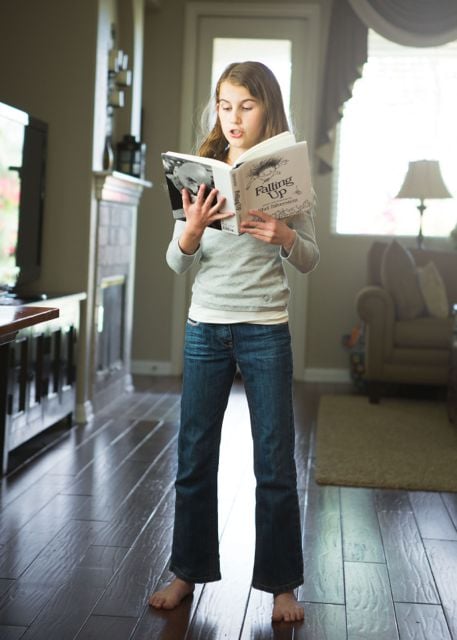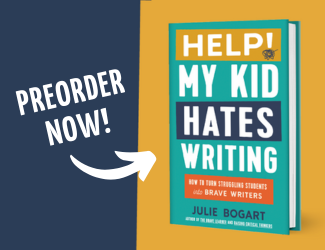The Value of Poetry
The Value of Poetry
It is difficult
to get the news from poems
yet men die miserably every day
for lack
of what is found there.
—William Carlos Williams
As we celebrate National Poetry Month, I just finished teaching Brave Writer’s annual “Playing with Poetry Workshop.” And once again, I recognized the intrinsic value of reading, teaching, and learning to write poetry to and with our kids.
So why should we study poetry in our homeschools?
Poetry teaches us the beauty and potential of the English language. The innovative use of language—of diction (word choice), metaphor and simile, other figures of speech, punctuation and capitalization—encourages our fledgling writers to take a chance with language. Our kids (and we parents alongside them) learn to play with words and language: transforming a noun into a verb, altering the “correct” use punctuation to create a fresh result, comparing two extremely different objects that seem to have no connection whatsoever, using alliteration (repeating initial consonant sounds in a line/sentence) for emphasis, employing a certain rhythm and cadence to our writing, and experimenting with new ways to entice readers through language.
Take a look at this apparently simplistic poem by e.e. cummings, one of the most innovative poets of the 20th century:
maggie and milly and molly and may
went down to the beach(to play one day)
and maggie discovered a shell that sang
so sweetly she couldn’t remember her troubles,
and milly befriended a stranded star
whose rays five languid fingers were;
and molly was chased by a horrible thing
which raced sideways while blowing bubbles:
and may came home with a smooth round stone
as small as a world and as large as alone.
For whatever we lose (like a you or a me)
it’s always ourselves we find in the sea.
This poem, which seems to be intended for children, has a lovely rhythm, containing rhyme in only the first and last couplets (a two-line stanza or “paragraph” in poetry), alliteration (the repeating “m-” sound at the beginning of words in the first line), simile (a “stone/as small as a world and as large as alone”), metaphor (“a stranded star/whose rays five languid fingers were”), personification (“a shell that sang/ so sweetly”), and a theme (message): “For whatever we lose (like a you or a me)/ it’s always ourselves we find in the sea.”
In the wonderful book Painless Poetry by Mary Elizabeth, she sets forth some excellent ideas for learning to enjoy poetry:
1. LOOK AT THE POEM
Notice the overall way the poem fills (or doesn’t fill) the page. It doesn’t look like the usual prose paragraphs we read in textbooks or novels, does it? Lines of poetry don’t cover the entire page. Also, look for breaks between groups of lines. Poems are often written in collections of lines that are called STANZAS—kind of like paragraphs of poetry. Stanzas consist of short, long, or different lengths of lines, most of which have at least several words. Each poem looks different, depending on the number and length of lines and stanzas; each poem is a unique creation, and being aware of each poem’s appearance is important in appreciating it.
2. EVERY WORD COUNTS
The precise meaning of a poem depends on the precise meaning of the words in the poem. The more familiar readers of poems are with words in a poem, the easier understanding and analyzing poetry can be. We need to keep our eyes and ears open and resist skipping words or phrases that we don’t understand in a poem; instead, we should always research unfamiliar words in dictionaries or online. If we don’t thoroughly understand each word and phrase in a poem, we may miss an important clue to the overall tone (mood/emotion) or meaning of a poem. Poetry is all about the details!
3. READ POEMS ALOUD – ALWAYS!
Poems are meant to be read aloud even if we are studying poetry by ourselves. Poetry is more than just the meaning of words: sound is central to understanding poetry. Listen for repeated sounds, words, and phrases (circle or underline them)—repetition is always a key to the poem’s meaning or tone. Also consider how the sound of the poem adds to the meaning or tone of the poem. Take note of rhyming words and other sound effects that may emphasize certain words and/or phrases. Again, sound effects often provide clues to the meaning and tone of poems.
4. THE WHOLE ENCHILADA!
The relationship between sound and meaning may not always be obvious, but possible relationships between sound and meaning may lead us to a deeper understanding of a poem. Consider images or memories that may be triggered by a poem and decide if they are important to understanding the poem. Always read a poem at least three times, if not more. We need to give ourselves the chance to pay attention to all of the elements of a poem each time we read it, and remember to read it ALOUD—always! Jot down any ideas about meaning or tone, any questions, anything at all in the margins of the poem. If you happen to be squeamish about writings in books, then make a copy of the page the poem is on and write on that copy.
Copywork is very important in understanding poetry, and it’s not only for our younger students. Even now as an adult, I still copy poems that grab my attention into my journal or commonplace book. Somehow, the poems become so much clearer to me as I linger over what flows from the nib of my pen: word by word, phrase by phrase, line by line, stanza by stanza. Writing poems out by hand slows us down, allowing us to think more deeply about an image or a metaphor; in addition, writing a poem in our own cursive penmanship helps us to make poem more ours—it gives us a feeling of kinship and/or ownership of the copied poem. It’s also lovely to have a journal full of the poems that speak specifically to each of us.
Composing different forms of poetry also reinforces our study of poets and their work. In the Playing with Poetry Workshop, we teach the basics of poetry analysis and structure and how to read and truly enjoy poetry. Then we experiment with composing free verse including autobiographical and “I Am From…” free verse poems; visual poetry including shape poems, concrete poems, and acrostics; cinquain and diamante poems; the Japanese poetry forms of haiku and tanka; conventional poetry, including couplets, tercets (and terza rima), quatrains, and limericks; and finally alternative poetry which encompassed fragmented poems, “After…” poems, kennings, and then various types of “found” poems including black-out poems, highlighted poems, and book spine poems, among others.
Some of the families from the Playing with Poetry Workshop reinforce the value of studying and writing poetry:
Jeena writes,
“We see poetry everywhere now and you have opened our eyes to many poetic forms. Poetry is now a topic I feel comfortable discussing, I used to shy away from it. Josh has widened his writing range. Most of all I want to thank you for a writing class that didn’t seem like a writing class. Josh, my usually reluctant writer, wrote fast and enthusiastically and never once complained. That really is a miracle for us! He felt encouraged, understood and positively challenged.”Linda shares,
“When I began this class I thought about poetry as something classical that I should have read or known about already but didn’t, as something silly and childish that rhymed, as something esoteric and mysterious. But now that I’ve taken this class I have fortunately had my eyes opened to new and amazing poetic possibilities. First of all anyone can write poetry, about anything. It just takes a willingness to play with sounds and words and ideas. Learning about free verse has been the most marvelous concept I have come across in a long time. I am so glad we began the course this way. I understand now why children find it so hard to write a poem (i.e., one that rhymes). All the effort goes into finding some unconvincing rhyme while all the lovely naturally spoken phrases and words that come unbidden out of a child’s mouth disappear unused into the ether. I also appreciate the fact that sometimes there isn’t anything to “get” about the poem. I can enjoy it as a delight of words instead of thinking I’ve missed some deeper meaning.“By working every day with poems and poetry my children definitely had a jump start in their understanding of elements and artistry. We talk the poetry lingo more intelligently now, flipping off phrases like, ‘Oh yes this stanza has an abab rhyming scheme’ and other perspicacious verbalisms. Seriously though, we are noticing things like alliteration, personification, similes, etc., etc., and thinking about persona more readily in poetry we read as well as recognizing it in our own poetry (where it still mostly happens by happy accident). We have had good discussions about appealing to senses other than the overused one of sight. We are beginning to be able to express why we might like this poem but not that one. There is still so much to learn, but at least we are unfolding in the right direction.”
So how can we celebrate National Poetry Month?
The Academy of American Poets hosts all sorts of poetry fun at their site. Here’s their page devoted to National Poetry Month. And they even have a National Poetry Month FAQ, so check it out!
It was through Poets.org that I first started reading the Poem-a-Day e-mails. A free service, recipients receive contemporary poems, usually unpublished and written within the last year on weekdays while weekends are reserved for classic poems in the public domain, a.k.a. “old friends.”
You may sign up for this amazing gift of starting your day with poetry here: Poem-A-Day. And it was recently revealed that the American Academy of Poets “…signed a deal with King Features to syndicate Poem-a-Day. This means that the new, previously unpublished poems we are publishing during the week will be available to editors at a wide range of newspapers, news websites, and magazines…. It’s been a generation since new poems have been available to daily news readers.”
In addition, Poets.org started the annual celebration of Poem-in-Your-Pocket Day in which we are encouraged to tuck a favorite poem (written by us or by a favorite poet) into our pocket and share it with at least one other person during the course of our day. Which day? Thursday, April 24 is the official Poem-in-Your-Pocket Day, so prepare!! More information can be obtained on the page Poem-in-Your-Pocket Day.
Also in celebration of National Poetry Month, students may write poems in response to poems written by professional poets: 2014 Poet to Poet Project. Very cool!!
So whether you take a trip to the library and check out some poetry books to peruse together during Poetry Teatimes, or look up some poetry forms and try to write them together as a family (involve dads, too—they can write some awesome poems!), or share a Poem from Your Pocket on April 24, find a way to make poetry part of your week—even part of your day—in your homeschooling life.
“You will find poetry nowhere unless you bring some of it with you.” ~Joseph Joubert
~Susanne Barrett, Brave Writer Senior Instructor (MA Poetry and British Literature)
Photo Credit: Tammy Wahl Photography



















[…] The Value of Poetry […]